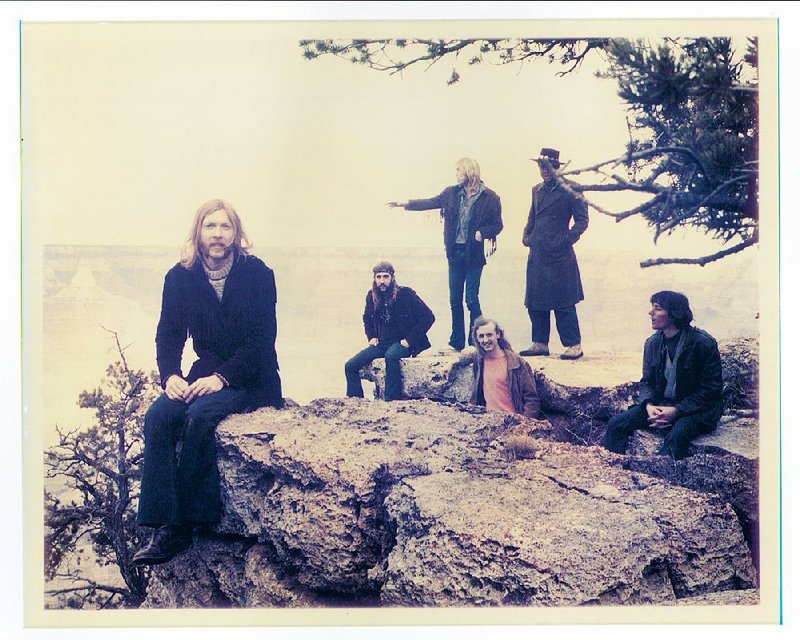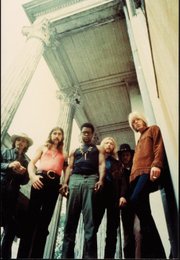On Feb. 20 in Wayne County, Ga., a movie production crew was preparing to film a scene for Midnight Rider, a movie about the life of Gregg Allman based on the singer-songwriter's 2012 autobiography My Cross to Bear. They'd placed a mattress and bed frame on a railroad trestle over the Altamaha River, for a dream sequence involving trains.
But for reasons that will likely be determined in court, the shot was interrupted by an interloping train, one ignorant of the film crew's intention and innocent of malice. Crew members reportedly had less than a minute to react; the director, Randall Miller, was one of 20 people who had to scramble out of the locomotive's path. An eyewitness said he fell and his life was saved when a still photographer pulled him off the tracks at the last second. Camera assistant Sarah Jones was not so fortunate -- she was struck by the train and killed. Six other crew members were injured.
In the aftermath, there was talk of shutting down production. Actor William Hurt, cast as Allman, was on the scene of the accident and subsequently pulled out of the movie. Allman, who is being credited as the film's executive producer, initially called for production to be shut down and later filed a lawsuit to force cancellation of the film. He dropped the suit in May after he and producers reportedly came to an out-
of-court agreement, the details of which were not disclosed. Director Miller and producers Jody Savin and Jay Sedrish have been charged with involuntary manslaughter and criminal trespass. Officially, work on Midnight Rider has been suspended.
The death of 27-year-old Jones is the latest sad chapter in the improbably long and tragic history of The Allman Brothers Band. It seems that death and broken faith and acrimony have followed this peculiar institution all its days. Maybe it's ironic that, just a month before the Midnight Rider accident, longtime (but not original) band members Warren Haynes and Derek Trucks announced they were leaving the band at the end of 2014, and Allman said its touring days were done.
For some of us, that's a melancholy development along the lines of Willie Mays retiring from center field. Or, the cynical might offer, the temporary demise of the Hostess Twinkie. Capitalism reanimates its earning engines, props them up and sends them out as a shadow of their former selves (see B.B. King) or hologram (see Michael Jackson, Tupac and Ol' Dirty Bastard).
My feeling is that The Allman Brothers Band died Oct. 29, 1971, when Gregg's older brother, Duane Allman, fresh out of rehab for heroin addiction and possibly impaired, rode his motorcycle through the waning dusk in Macon, Ga. A flatbed truck pulled into the intersection he was approaching and stopped. Duane locked up the the brakes and swerved but hit the rear of the truck. He was thrown from his Harley-Davidson Sportster; the bike landed on him and skidded 90 feet with him beneath it. He was 24 years old when he died.
And if that wasn't the end, then it came a year and two weeks later when Berry Oakley, the band's melodic bass player, ran his motorcycle into the side of a bus three blocks away from Duane's wreck. Oakley was also 24.
Somehow, the band persisted. Off and on for 43 years, it toured and cut records -- some of them pretty good. It retained three of its original members -- Gregg Allman and drummers Jai Johanny "Jaimoe" Johanson and Claude Hudson "Butch" Trucks -- until the end. Dickey Betts didn't completely divorce the band until 2000. Along the way, they brought in some exceptional players like guitarists Warren Haynes and Derek Trucks (nephew of original member Butch Trucks) and keyboardist Chuck Leavell. While the post-Duane Allman and Oakley lineups weren't as fluid and flighty -- they missed Duane's jazzy interlocutions, his willingness to push out into the spacey territories of his heroes Miles Davis and Robert Johnson -- they did allow second lead guitarist Betts to display his genius through an earthier style, rooted in blues and bluegrass and acoustic string band chestnuts, which he delivered in stinging tremelo.
In retrospect, the lineups were all right after Eat a Peach, the album released four months after Duane's death -- they just weren't really The Allman Brothers Band. They were a mess, an ongoing soap opera featuring homicide (see Twiggs Lyndon); a long season of acrimony over a drug trial (Scooter Herring); allegations of financial mischief on the part of the record company; artistic and physical dissipation; Allman's marriage to Cher; breakups and breakdowns and a slow spiral from the very top of their chosen profession to the minor leagues of rock. (Those looking for a comprehensive history of the band should seek out the recently published One Way Out: The Inside History of The Allman Brothers Band by Alan Paul, who has tracked the band's progress for 25 years.)
Yet in 1971, distinguished by the twin lead guitars of Betts and Duane Allman and the throaty, gritty vocals of little brother/organist Gregg, The Allman Brothers Band was the greatest rock 'n' roll band in the world.
BROTHERS
Duane and Gregg were born one year apart, in 1946 and '47 respectively, in Nashville, Tenn. Their father died when the boys were young and, by the time they were in junior high, the family had moved to Daytona, Fla. Here they absorbed an eclectic range of radio music, including blues and country. By their teens, they were playing in local bands.
In 1965 they formed a four-piece group called the Allman Joys and cut their first record, a version of Willie Dixon's "Spoonful." A year later they moved to Hollywood, where they spent the next few years recording demos. They signed a record contract as part of a group called Hour Glass.
Their stay in Hollywood was relatively uneventful. Gregg met Jim Morrison and for a time roomed with a young singer-songwriter named Jackson Browne. By 1968, Duane had moved back to the South, where he latched onto a highly lucrative gig as a session guitarist in Muscle Shoals, Ala., playing on songs by artists such as Aretha Franklin, Wilson Pickett, Boz Scaggs, Delaney & Bonnie and others. He supplied a slinky slide counterpoint to Eric Clapton's work on Derek and the Dominoes' "Layla."
But Duane wanted to front his own band, and soon he convinced Gregg to come home from California and form one. They hooked up with drummer Butch Trucks and a Jefferson Airplane-style band called The Second Coming that featured guitarist Betts and bassist Oakley. Legend has it that they jammed together and knew they had something special. They added a second drummer -- Johanson -- and called it The Allman Brothers Band, a prosaic name that was a reaction to the then-conventional practice of giving bands surreal monikers.
Their debut album, given the similarly straightforward name The Allman Brothers Band, was recorded in New York in 1969 and relies heavily on reworked blues. (As Hour Glass, the brothers were prohibited from playing blues standards. They were supposed to write their own songs.) While the album didn't cause much of a stir when released, it ushered in a new approach to American pop. Duane Allman and Betts dueled with guitars and, if Gregg's singing sounded a little over the top, it wouldn't be long before he refined his style.
Their second effort, 1970's Idlewild South, fulfills the promise hinted at on the first album. It features the gentle instrumental "In Memory of Elizabeth Reed" and is marred only by Oakley's hoarse shouting on the chestnut "Hoochie Coochie Man."
Then it was time to make the third album. And the Allmans knew they were better live than in the studio.
LIVE AT FILLMORE EAST
I do not know if you need all six CDs (or three "surround sound Blu-rays") which comprise the just-released The 1971 Fillmore East Recordings (Mercury/Universal). If you have the original At Fillmore East, which consists of seven tracks originally spread across two LPs, you have what some consider the best live rock album ever recorded.
(I might go with James Brown Live at the Apollo. Or The Kinks Live at Kelvin Hall, which was released in the United States as The Live Kinks. Or The Band's Rock of Ages. But At Fillmore East is the best album recorded by the best live rock 'n' roll outfit ever.)
It's convenient to credit the group, and maybe Duane Allman in particular, as the principal architect of what came to be called Southern rock. This is fine as far as it goes, so long as we understand Southern rock as more a reaction to the excesses of late '60s psychedelia than reductive provincial cheerleading occasionally relieved by 38 Special's pop anthemizing.
The Allman Brothers were never simply loud and obnoxious boogie artists. They were subtle, intelligent musicians who -- along with the Grateful Dead and Cream -- pioneered the progressive, improvisational possibilities of rock. Their early work combines the earthy imperatives of Delta blues with the ethereal sky-crying of John Coltrane. They could stretch out and jam, but their jams only occasionally came across as self-indulgent or meandering.
They were less about flourish and expressionistic lyrics than about the insistent pulse of the music. While, compared to the Rolling Stones or The Who, Betts and Gregg Allman, the band's chief songwriters, were relatively weak, they instrumentally pushed rock beyond the parameters of the three-minute song without abandoning the integrity of the tune.
Southern rock was provincial, reactionary and culturally conservative. Like the rock 'n' roll of the '50s, Southern rock drew from black blues and white country-and-western styles and was entirely self-contained. The music existed not to make a point or send a message, but to cause hearts to flutter and feet to move.
The Allmans believed in melody. Just when you thought they'd wandered off, they'd bring it back to that -- Betts would pull his razor out of his boot and clean melodic country picking would cut through the great clouds of brewed-up foggy noise.
On At Fillmore East, Duane Allman and Betts stretch out on the classics "Statesboro Blues" and "Stormy Monday," reprise "Elizabeth Reed," and generally avoid self-indulgent overplaying. Every note stings, blisters or applies sweet balm. If you can't appreciate it, you just don't get what rock music is supposed to be about.
Admittedly I geek out on this stuff -- I think it's great to have everything the band played that weekend in March 1971, four complete sets, 37 tracks, 15 of which have never been released. But I don't really need two more alternate versions of "Whipping Post," though the quality of the performances is remarkably consistent, aside from an ill-advised (and probably under-rehearsed) saxophone on the first night's versions of "In Memory of Elizabeth Reed." I'd argue that producer Tom Dowd got it right when he selected the cuts for the original album -- those are the best takes.
What's most remarkable about the set is the moment it captures -- the Allmans came into the weekend as the opening act for Johnny Winter; by the end of the weekend they were closing the show.
A few months later it was all over, although they'd persist for 43 more years.
Email:
pmartin@arkansasonline.com
blooddirtangels.com
Style on 08/10/2014

